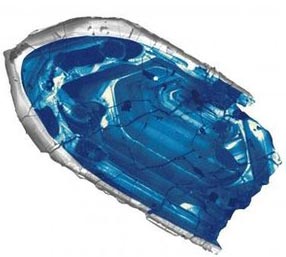New Study Suggests the Early Earth Cooled Much Earlier Than Previously Thought
Analysis of a microscopic fragment of the mineral zircon, part of a collection of minerals excavated from a remote outcrop of rock in Australia is helping scientists to understand how our planet became cooler and able to support simple chemistry that would ultimately lead to the evolution of life. The research published this month, suggests that the Earth may have been able to support simple life forms about 4.4 billion years ago, less than 200 million years after the planet first formed.
The Age of Planet Earth
The research team, led by Professor John Valley from the University of Wisconsin-Madison) have produced evidence to suggest our planet was able to sustain life earlier than previously thought. The solar system that contains our planet is believed to have formed around 4.56 billion years ago. An enormous cloud of gas and dust (a solar nebula), formed after the extinction of a previous celestial body began to collapse in on itself under the influence of gravity.
The mass of dust and gas became flatter and formed a rapidly turning, spinning disc.
At the centre, it became extremely hot and the sun was formed. Debris orbiting this embryonic sun began to separate out with the less dense elements moving to the outer rings. The inner rings formed the rocky planets, the outer rings formed the gas giant planets like Saturn, Jupiter and the “ice giants” Uranus and Neptune. Remaining debris formed the asteroid belt between Mars and Jupiter as well as a number of other satellites and mini planets (Pluto).
Working with previous lead isotope analysis and data that proved the zircons extracted from rocky exposures in Western Australia’s Jack Hills region were the most ancient parts of the Earth’s crust, the zircon used in this new study has been confirmed as the oldest known material of any kind known on Earth.
Placing the Zircon Mineral within the Concept of Deep Time
Picture credit: Andree Valley
The Earth Cooled
Commenting on the significance of this new zircon study, Professor Valley explained:
“This strengthens the theory of a cool early Earth, where temperatures were low enough for liquid water, oceans and a hydrosphere to form not long after the planet’s crust congealed from a sea of molten rock This study reinforces our conclusion that Earth had a hydrosphere before 4.3 billion years ago and possibly life not long after.”
New Method of Study
A brand new method was used in the study and analysis of the zircon sample. This new technique is called atom-probe tomography and when this method is used in conjunction with ion mass spectrometry it gives scientists the opportunity to establish with astonishing accuracy the age and thermal history of the material.
The mass of individual lead atoms was calculated and analysis of these “clusters” of lead atoms suggests that these groups of lead formed around one billion years after the zircon first formed. Using measurements of radioactive decay the team established the history of the zircon through deep time, calculating that the age of the mineral studied.


